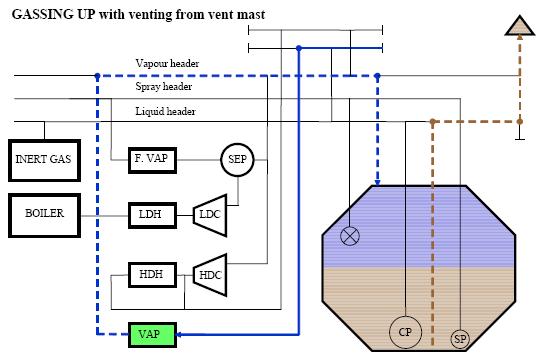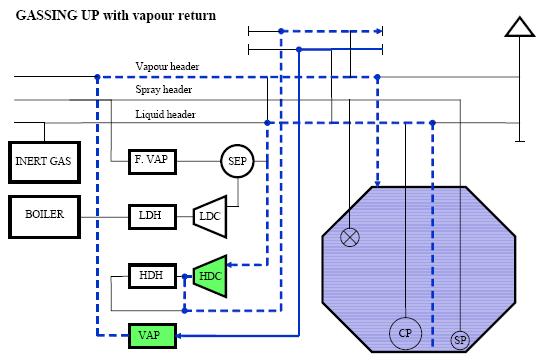

Home page|||
LNG handling |||
LPG handling||| Other Gas products|||
Fire & Safety|||
Emergency response |||
Gassing-up tanks procedure for loading LNG cargo on board
Prior to commencing any gassing up operation it is important to ensure that all gas detecting equipment
(fixed and portable) is operating correctly and has been calibrated as per the manufacturers’
requirements.During gassing up, the inert gas in the cargo tanks is replaced with warm LNG vapor. This is done to remove carbon dioxide and to complete drying of the tanks.
Gassing up operational cycle
After lay-up or dry dock, the cargo tanks are filled with inert gas or nitrogen. If the purging has been done with inert gas, the cargo tanks have to be gassed up and cooled down when the vessel arrives at the loading terminal. This is because, inert gas contains about 14% carbon-dioxide, which will freeze at around -60ºC and produces a white powder which can block valves, filters and nozzles.
During gassing up, the inert gas in the cargo tanks is replaced with warm LNG vapor. This is done to remove carbon dioxide and to complete drying of the tanks. The LNG vapour is lighter than the inert gas, which allows the inert gases in the cargo tank to be
exhausted up the tank filling line to the liquid header. The inert gas then vents to the atmosphere
via the vent mast.
(1) Supply of LNG for gassing up
LNG liquid is supplied from the terminal to the liquid manifold where it passes to the stripping/spray header via the appropriate ESDS liquid valve. It is then fed to the main vaporizer and the LNG vapour produced is passed at a temperature warmer than the dew point temperature existing within the cargo tanks through the vapor header and into each tank via the vapor suction fitted in the upper part of the tank. This method of gassing up is called “Piston Flow Method”. In this the lighter specific gravity LNG vapor is injected from top and the heavier IG is displaced from bottom.

Fig:Gassing up with venting from vent mast
(2) Requirement to purge with Nitrogen.
At the start of the operation, the piping system and main vaporizer contain inert gas. Consequently to avoid the formation of water condensate or solid CO2, the supply line to the vaporizer from the manifold has to be first purged with Nitrogen either by using the ships or shore supplying.
(3) Completion criteria
When 5% methane (% figure will be specified by the particular port authority) is detected at the vent mast riser, the exhaust gas is directed ashore.
The operation is considered complete when the methane content, as measured at the top of the cargo filling pipe, exceeds 98% by volume.
Due to local regulations on venting methane gas to the atmosphere, some port authorities may require the entire operation to be carried out with the exhaust gases being returned to shore facilities.
When about 5% Methane (actual figure will be determined by the terminal or port authority) is
detected at the vent mast the exhaust gas is directed ashore via the HD compressors or to the
boilers via the gas burning line. It may be possible to conduct this part of the operation without
using compressors subject to back pressure requirements. Where possible it is preferred not to
use the compressors in order to avoid turbulence in the tanks. Some terminals may require the
operation to be completed with all exhaust gas returned ashore.
The operation can in certain circumstances be considered complete when the Methane content, as
measured at the top of the cargo filling pipe, exceeds 80% by volume; however, more typically a
figure close to 100% Methane is preferred. The target value for N2 and Co2 is equal or less than
1%, the terminal requirements should be discussed when deciding upon the exact figures.
The exact sequence of operation and burning is to be discussed and agreed with the terminal in
advance of commencing operations. All agreed procedures should be fully documented and signed
by both parties.
There are exceptional cases where it may be necessary to undertake the purging of cargo tanks at
sea using LNG from another tank. In this case the liquid will be supplied from a stripping/spray
pump to the stripping/spray header, the operation will then proceed in a manner similar to the
above.
Methane is a
greenhouse gas and detrimental to the environment therefore seek authorization from shore before venting Methane to the atmosphere.

Fig:Gassing up with vapour return
Related Information:
- Inerting of Cargo Tanks prior loading LNG cargo
- Initial Cool Down of cargo tanks
Procedure for loading Liquefied Gas Cargoes
Procedure for Cargo Conditioning in Liquefied Gas Carriers
Cargo Transfer between Vessels (STS Operation)
Procedure for segregation of Liquefied Gas Cargoes
Procedure for Stripping Liquefied Gas Cargoes
Procedure for Changing Liquefied Gas Cargoes
Displacing Atmosphere with Inert Gas (Inerting)
Displacing with Vapour of the Next Cargo (Purging)
Procedure for Water washing after Ammonia Cargoes

// Home page///
LNG handling ///
LPG handling///
Sea transport ///
Gas products///
Cargo work
///Fire precautions
///Health hazards
///Safety Precautions
///Emergency response ///

Copyright © Liquefied Gas Carrie.com All rights reserved.
The content published in this website are for general reference only. We have endeavoured to make the information
as accurate as possible but cannot take responsibility for any errors. For latest information please visit www.imo.org .
Any suggestions, please Contact us !
///Links &Resources //
Terms of use///
Privacy policy///Home page///
